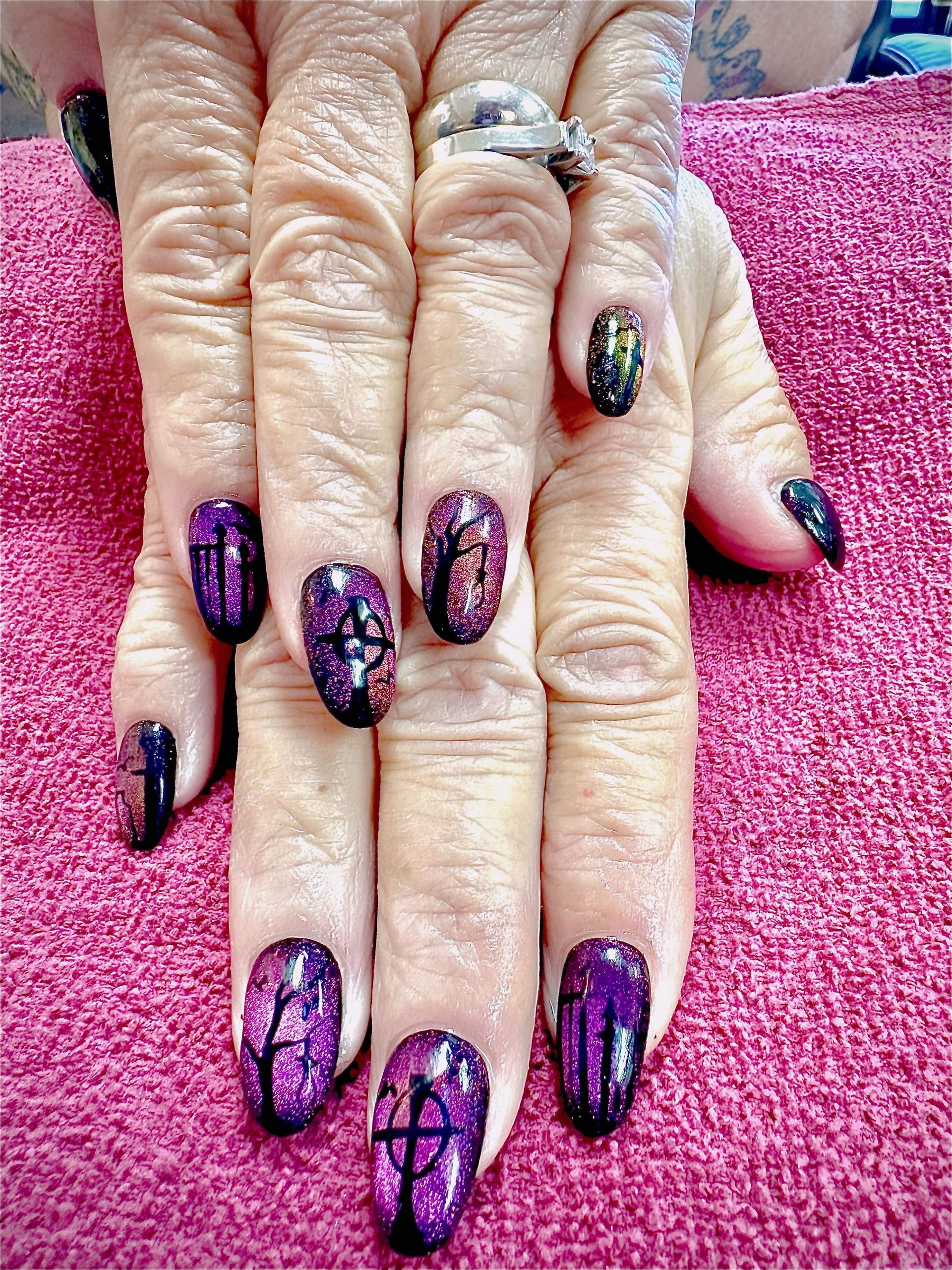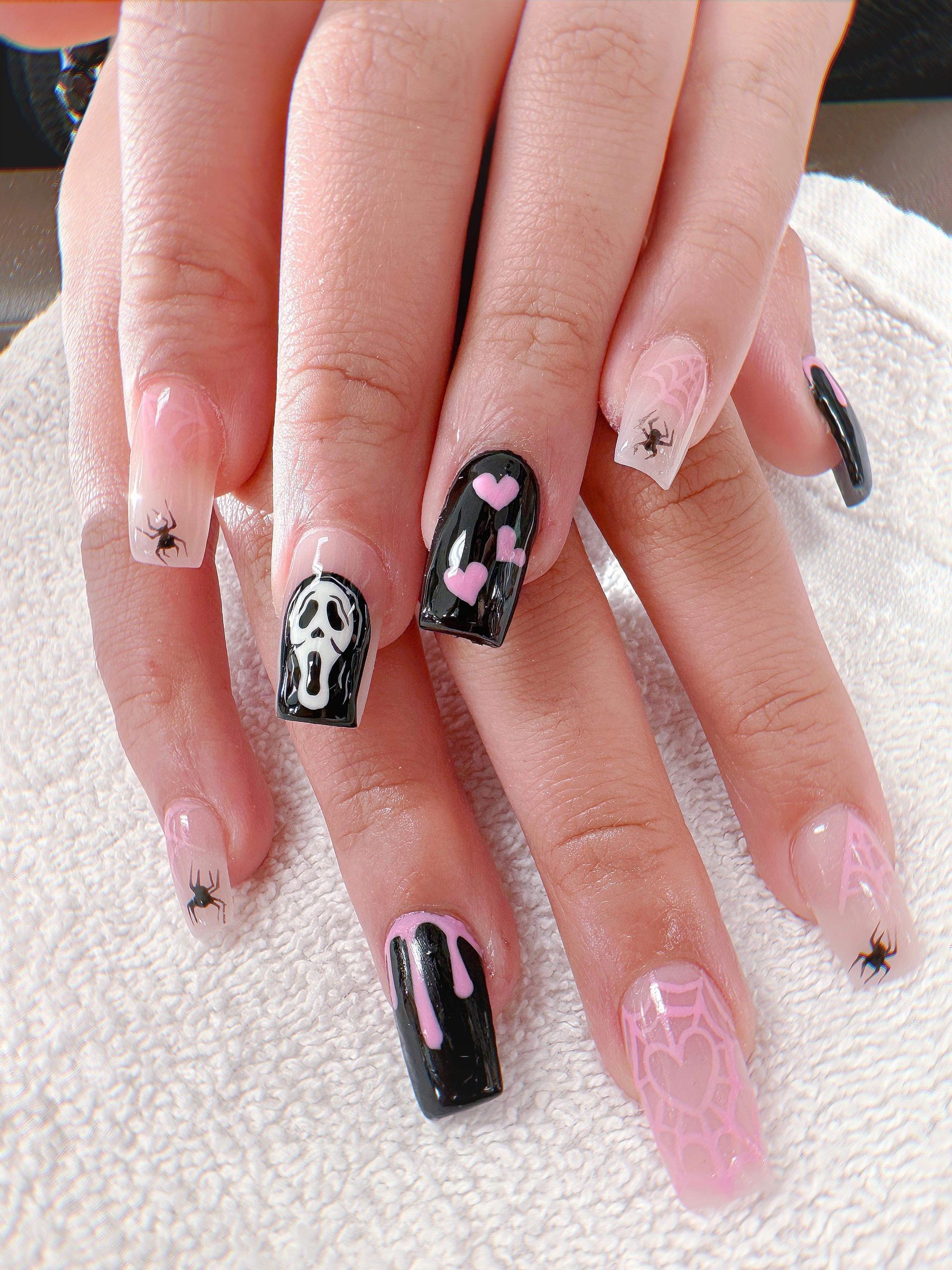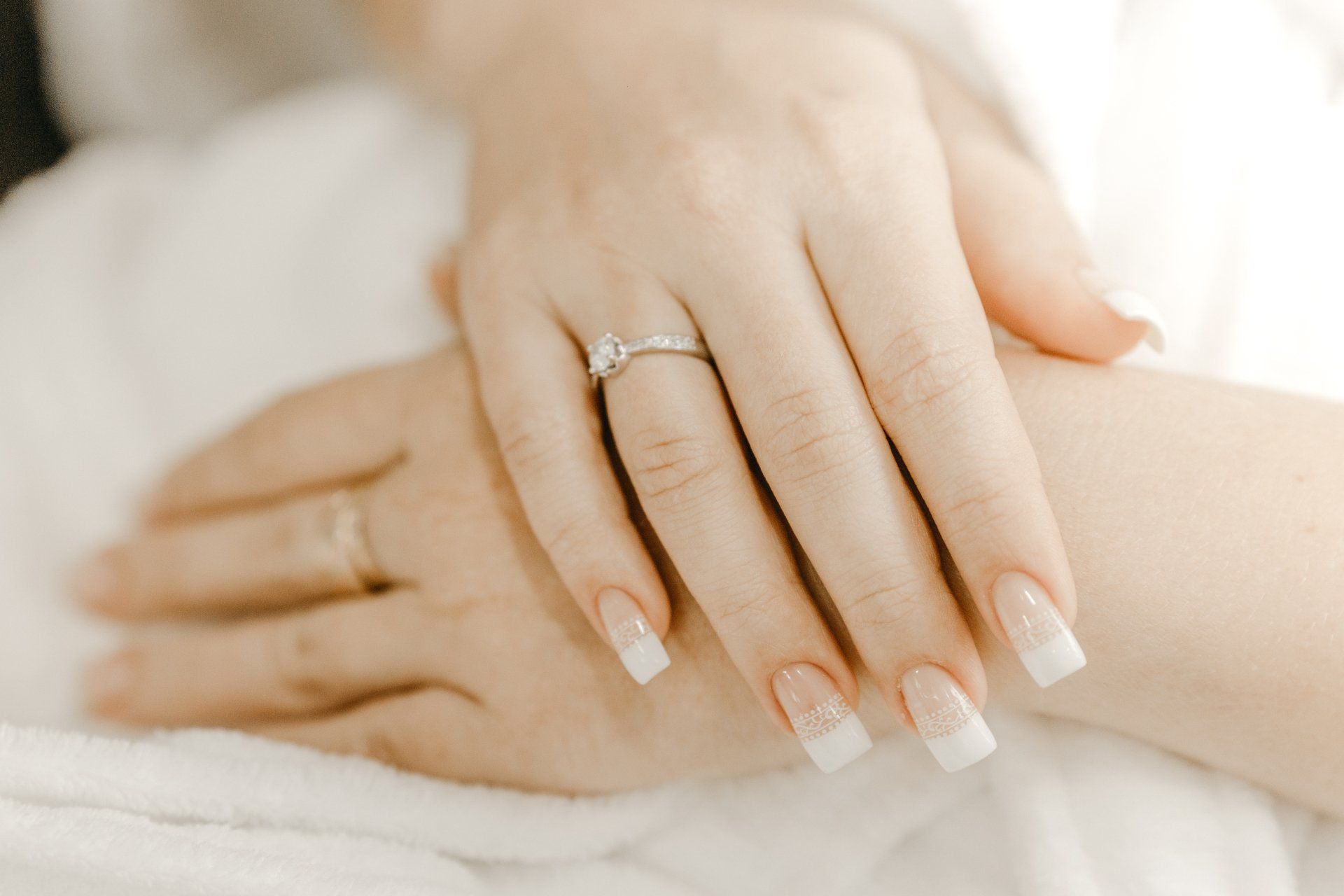Understanding UV and LED Gel Manicure Lamps
UV and LED gel manicure lamps differ in the type of light they emit: UV lamps use ultraviolet light, while LED lamps use light-emitting diodes. UV lamps have a broader wavelength range, affecting curing time and depth. LED lamps emit a specific wavelength for quicker curing and longer-lasting shine. UV lamps are cost-effective, durable, and ensure thorough curing, while LED lamps offer speedy curing and durability without harmful UV rays. Understanding these differences is crucial for achieving a flawless, lasting manicure. Mastering the distinctions in light emission and curing mechanisms can elevate your nail game to the next level.
Key Takeaways
- UV lamps use ultraviolet light for gel curing, while LED lamps use light-emitting diodes.
- UV lamps offer thorough curing with a broader light spectrum, while LED lamps provide quick curing with specific wavelengths.
- UV lamps are cost-effective and durable, requiring fewer replacements, while LED lamps offer long-lasting shine and quick manicures.
- UV lamps activate photo initiators for polymerization, ensuring longevity, while LED lamps cure gel polish in 30-60 seconds per layer.
- UV gel lamps are budget-friendly and efficient, while LED gel lamps ensure glossy, chip-free manicures lasting up to three weeks.
Differences Between UV and LED Lamps
When comparing UV and LED gel manicure lamps, one significant difference lies in the type of light they emit. UV lamps use ultraviolet light, while LED lamps use light-emitting diodes to cure gel polish. This variance in light sources affects the gel curing process and the overall outcome of the manicure.
UV lamps operate at a broader range of wavelengths, emitting a spectrum of light that activates photo initiators in the gel polish to start the curing process. On the other hand, LED lamps emit a narrower spectrum of light focused on a specific wavelength, which targets the photo initiators more efficiently. This difference in light wavelength influences the curing time and the depth of cure for the gel polish.
Understanding these light wavelength differences is crucial for nail technicians aiming to provide efficient and high-quality gel manicures. By selecting the appropriate lamp for the gel polish being used, professionals can optimize the curing process and ensure durable and long-lasting manicures for their clients.
How UV Lamps Work
UV lamps, commonly utilized in gel manicures, function by emitting ultraviolet light to initiate the curing process of gel polish. When the UV lamp is turned on, it produces a specific type of ultraviolet light within the light spectrum that interacts with the photosensitivity properties of the gel polish. This interaction triggers a chemical reaction in the gel polish, causing it to harden and cure to a durable finish.
The light spectrum emitted by UV lamps is crucial for the curing process because it activates the photo initiators present in the gel polish. These photo initiators are compounds that respond to specific wavelengths of light, which in this case, are the ultraviolet rays emitted by the lamp. As the gel polish is exposed to the UV light, the photo initiators absorb the energy and kickstart the polymerization process, transforming the gel from a liquid to a solid state.
Understanding how UV lamps work in gel manicures is essential for achieving long-lasting and flawless results. By harnessing the power of ultraviolet light and its photosensitivity properties, professionals can ensure that gel polish cures efficiently and effectively, providing clients with beautiful and durable manicures.
How LED Lamps Work
LED lamps, like their UV counterparts, operate by emitting light to initiate the curing process of gel polish. The light spectrum produced by LED lamps is specific to wavelengths that activate the photo initiators in gel polish, leading to efficient curing. Unlike UV lamps, LED lamps consume less energy and have a longer lifespan, making them a more sustainable choice. LED technology is known for its durability, with bulbs lasting up to 50,000 hours of normal usage. This longevity translates to cost savings and reduced environmental impact. The efficiency of LED lamps also means quicker curing times, allowing for faster manicures without compromising quality. Additionally, LED lamps do not emit harmful UV rays, making them a safer option for both clients and technicians. Overall, the advanced technology and benefits of LED lamps make them a popular choice in the nail industry for achieving beautiful and long-lasting gel manicures.
Benefits of UV Gel Lamps
In our experience working with gel manicures, we have found that UV gel lamps offer unique benefits that cater to specific needs in the nail industry. One key advantage of UV gel lamps is their ability to provide excellent longevity and durability to gel manicures. The UV light emitted by these lamps ensures that the gel polish cures thoroughly, leading to a longer-lasting manicure that is less prone to chipping or peeling.
When considering cost and maintenance, UV gel lamps can be a cost-effective option for nail technicians and salon owners. These lamps are often more affordable upfront compared to LED lamps, making them a budget-friendly choice for those starting out or looking to expand their services. In terms of maintenance, UV gel lamps generally require fewer replacements and repairs, adding to their overall cost efficiency.
Benefits of LED Gel Lamps
When seeking optimal efficiency and versatility in gel manicure curing technology, LED gel lamps stand out as a superior choice. LED gel lamps offer a range of benefits that make them a popular option for both professionals and at-home users. One of the key advantages of LED gel lamps is their quick curing time. LED lamps can cure gel polish in as little as 30 to 60 seconds per layer, significantly reducing the overall manicure time. This quick curing feature not only saves time but also helps prevent smudges and dents, providing a flawless finish.
Additionally, LED gel lamps are known for producing long-lasting shine. The LED technology ensures that the gel polish cures evenly, resulting in a durable and glossy finish that can last up to two to three weeks without chipping or fading. This extended wear time makes LED gel manicures a convenient choice for individuals looking for a low-maintenance nail solution that stays vibrant and shiny for an extended period.
Frequently Asked Questions
Can UV or LED Gel Lamps Cause Skin Cancer?
Yes, UV or LED gel lamps, commonly used for nail treatments, can pose a skin safety concern due to potential cancer risks. To mitigate this, exploring alternative lighting options is crucial. Our experience highlights the importance of prioritizing skin health while enjoying nail treatments. It's imperative to be informed about the potential risks and take proactive steps to ensure a safe and enjoyable beauty routine.
Are There Any Health Risks Ass
ociated With Using Gel Lamps?
We've got you covered! When it comes to using gel lamps, it's crucial to consider potential health risks. One key aspect is ensuring proper eye protection to shield your eyes from the UV rays emitted by these lamps. Additionally, prolonged exposure may lead to nail damage over time. By taking necessary precautions and using gel lamps responsibly, you can enjoy beautiful nails without compromising your health.
How Long Do UV and LED Gel Manicures Last?
UV and LED gel manicures typically last around two to three weeks with proper maintenance. To keep them looking fresh, we recommend regular upkeep like moisturizing cuticles, avoiding harsh chemicals, and using gloves for chores. When it's time for removal, soak nails in acetone for about 15 minutes, gently push off the softened gel, and moisturize afterwards. Following these tips can help maximize the longevity of your gel manicure.
Can UV or LED Gel Lamps Be Used on Natural Nails?
Yes, UV or LED gel lamps can be used on natural nails for a longer-lasting manicure. When it comes to nail care, these lamps are essential for curing gel polish. Proper application techniques ensure a smooth finish. Maintenance tips include keeping cuticles hydrated and applying cuticle oil regularly. By using UV or LED gel lamps on natural nails, you can enjoy beautiful, chip-free manicures that last for weeks.
Do UV or LED Gel Lamps Emit Harmful UV Radiation?
Yes, UV and LED gel lamps do emit UV radiation. UV lamps emit higher levels of UV radiation compared to LED lamps. It is essential to apply gel polish correctly to minimize exposure to harmful UV rays. Ensuring proper application techniques and limiting exposure time can help reduce any potential risks associated with UV radiation from these lamps. It's crucial to prioritize safety when using UV or LED gel manicure lamps for nail treatments.
Gallery
Related Topics Nail Salon Services
Choosing the Right Gel Manicure for You
Gel Manicure vs. Regular Manicure: Understanding the Differences
How Long Does a Gel Manicure Last?
The Process of Getting a Gel Manicure
Removing Gel Manicures Safely and Effectively
Tips for Maintaining Your Gel Manicure
Understanding UV and LED Gel Manicure Lamps
What to Expect During a Gel Manicure Appointment
Find Us
Contact
Contact Us
We will get back to you as soon as possible
Please try again later
nail salon
salon
nail salon
spa
nail
salons
nail salons
nail salon
nail salon
nails
services
nail
salon
business
nail salon
nail salon
nail salon
manicure
manicure
manicure
manicure
manicure
best
quality
nail salon springfield
nails salons
nails shop
salon
manicure
spa
nail
salons
nail salons
manicure
nail salons
beauty salon
shellac
venus
nails salon
committed
technicians
business hours
spa
top
nails spa
mani
solar
dipping
nail salons
place
contact
beautiful
salons
nail salon
nail salon
nail salons
nailbar
nails
gel nails
nail enhancements
self-care
artificial nail
nail salons
nails
services
nail
nail salon
nail salon
nail salons
nailbar
nails
gel nails
nail enhancements
self-care
artificial nail
best nail
nails
services
nail
What are the best nail salons for kids?
What are some popular services for nail salons?
What are people saying about nail salons in Springfield, MO?
What is the best nail salon in Springfield?
manicure nail nail salon gel and shella nail designs nail salons nailbar nails nails salon nails salons nails shop salon salons shop gel and shella nail designs gel and shella nail designs nail designs beauty salon manicure salon for nails Discover the Ultimate Nail Experience at Manicure Nail SalonDiscover the Ultimate Nail Experience at Manicure Nail Salon
Are you in search of the perfect nail salon nails near you nail salon nail salon Manicure Nail Salon nail salon nails meet top-notch pampering. Our salon is your go-to destination for all things nail salon, providing a haven of relaxation and rejuvenation.
At Manicure Nail Salon, we take pride in being one of the finest nail salons in nail salon. Our expert technicians are dedicated to crafting the most stunning and long-lasting nail art in the area. Whether you're looking for a classic manicure or a trendy nail design, we've got you covered.
Nail Salons Springfield: nail salon
What sets us apart from other nail salons Springfield has to offer? It's our commitment to excellence and attention to detail. Our professional staff knows that the beauty of your nails lies in the finer points. With an array of colors, designs, and styles to choose from, your nail salon Springfield experience will be truly unique.
At our nail shop, we use only the highest-quality products to ensure the health and longevity of your nails. Our exclusive range of nail polishes and treatments will leave your nails looking flawless and feeling stronger than ever.
Nail Artistry That Shines
Whether you're getting ready for a special occasion or simply treating yourself to a well-deserved break, our nail artistry will leave you speechless. Our technicians are skilled in the latest nail techniques, from intricate nail extensions to breathtaking nail designs.
Nail Services for Every Occasion
At Manicure Nail Salon, we offer a wide range of nail services to cater to your specific needs. From classic manicures and pedicures to luxurious spa treatments, our salon is your one-stop destination for all your nail care needs.
nail salons springfield, nail salons springfield
If you're in Springfield, Missouri, and in search of the finest nail salon has to offer, look no further than Manicure Nail Salon. Our dedicated team is ready to pamper you with the best in nail services. Come visit us today and experience the ultimate in nail luxury.
Don't miss out on the opportunity to transform your nails into works of art. Book your appointment at Manicure Nail Salon now, and let us elevate your nail game to new heights.
The Art of Manicures: Nail Enhancement
When it comes to self-care and pampering, one of the most popular choices for individuals in Springfield, Missouri, is indulging in exquisite manicures. A well-executed manicure can transform not just your nails, but your entire outlook, leaving you feeling confident and rejuvenated. In this comprehensive guide, we delve into the world of manicures nail salon nail enhancement services and salons that cater to all your nail needs.
The World of Manicures
Exploring Manicures
Manicures have come a long way from being simple nail grooming sessions. Today, they are an art form in their own right. A professional manicure involves a meticulous process that includes cleaning, shaping, and beautifying your nails. Whether you're looking for a classic manicure or something more adventurous, Springfield has it all.
Nail Enhancement: Taking Manicures to the Next Level
For those seeking to elevate their nail game, nail enhancements are the way to go. Nail enhancement techniques encompass a variety of options, including nail extensions, gel overlays, and intricate nail designs. These techniques not only add length and durability to your nails but also offer an opportunity for creative expression.
Springfield's Manicure Scene
The Best Manicure Salons
Springfield boasts a thriving manicure scene, with numerous salons offering top-notch services. Among them, a few stand out as true gems for nail aficionados.
- Nail Nirvana: This salon is a haven for those seeking the perfect manicure. Their skilled technicians offer a wide range of services, from basic manicures to dazzling nail enhancements.
- Elegance Nails: Known for their attention to detail, Elegance Nails is a favorite among Springfield residents. They specialize in gel manicures that last for weeks, keeping your nails looking impeccable.
Exploring Nail Enhancement
Nail Extensions: A Game Changer
Nail extensions have become increasingly popular, offering the possibility of longer and more glamorous nails nail salon nail enhancement experts use high-quality materials to ensure durability and natural aesthetics.
Gel Nails: Beauty and Durability
Gel manicures and nail enhancements have taken the beauty industry by storm. These long-lasting options provide both strength and style to your nails, making them a preferred choice for many.
Nail Care Tips
Maintaining Your Manicure
To make the most of your manicure and nail enhancements, it's essential to follow some basic care tips. Regularly moisturize your cuticles, avoid using your nails as tools, and schedule routine touch-ups to keep your nails looking pristine.
Conclusion
nail salon manicures and nail enhancements is thriving. Whether you're seeking a classic manicure or adventurous nail art, Springfield's manicure scene has something for everyone. Discover the artistry and craftsmanship of Springfield's finest nail enhancement salons, and indulge in the luxury of perfectly groomed nails. Your journey to impeccable manicures starts right here in manicure.
Elevate Your Beauty: Unique Manicures at Uniquely Herr's Nail Salon
In the world of manicures, where precision meets creativity, Uniquely Herr's Nail Salon stands as a beacon of excellence. Located in the heart of the city, this salon is not just a place for routine manicures, but a hub of artistic expression and nail enhancements that redefine beauty standards.
The Artistry of Manicures
Manicures are no longer just about neat and trimmed nails. They are an art form, a canvas upon which skilled technicians create miniature masterpieces. At Uniquely Herr's, manicures are elevated to an art form that combines precision and innovation.
Imagine stepping into a salon where your nails become the focus of attention, where they are treated with utmost care and expertise. Uniquely Herr's Nail Salon offers a range of manicure services, from classic to avant-garde, all designed to pamper and beautify your nails.
Exploring Nail Enhancement
A World of Possibilities
Uniquely Herr's is not just about manicures; it's about nail enhancement possibilities that are boundless. Whether you desire longer nails, intricate nail designs, or the elegance of gel overlays, this salon has it all.
Nail enhancements at Uniquely Herr's are a fusion of artistry and technology. The technicians are adept at using high-quality materials to create nail enhancements that not only look stunning but also stand the test of time.
Nail Extensions: The Game-Changer
For those yearning for longer nails, nail extensions are a game-changer. Uniquely Herr's takes this to the next level with the latest techniques and materials. Whether you opt for the natural look or the bold and dramatic, nail extensions are the perfect solution.
Gel Nails: Beauty and Durability
Gel nails have become a symbol of beauty and durability in the world of manicures. Uniquely Herr's uses cutting-edge gel products that provide strength and style. The result? Gel manicures that not only look fabulous but also last for weeks.
The Unique Experience
At Uniquely Herr's Nail Salon, it's not just about manicures and nail enhancements; it's about the entire experience. The moment you step in, you are welcomed into a world of luxury and pampering.
The salon's ambiance is a blend of modern aesthetics and comfort, designed to make you feel relaxed and rejuvenated. The skilled technicians pay meticulous attention to every detail, ensuring that your manicure or nail enhancement is a work of art.
Nail Care Tips
To maintain the longevity of your manicures and nail enhancements, here are some tips to keep your nails looking impeccable:
- Regularly moisturize your cuticles to keep them soft and healthy.
- Avoid using your nails as tools for tasks that could cause damage.
- Schedule routine touch-ups to maintain the beauty of your manicures.
manicure
Uniquely Herr's Nail Salon is not just a salon; it's a destination for those who appreciate the artistry of manicures and the allure of nail enhancements. It's a place where your nails become a canvas for creativity and a symbol of your unique style.
Elevate your beauty, pamper your nails, and indulge in the luxury of Uniquely Herr's Nail Salon. Your journey to impeccable manicures and breathtaking nail enhancements begins here. Visit us and experience the difference that uniqueness makes.
Uniquely Herr's Nail Salon: Where Beauty Meets Artistry.
Manicure nail salon Springfield, Missouri Manicure nail salon Springfield Manicure nail Springfield, Missouri Manicure nail salons Springfield, Missouri Manicure nail salonmanicure
manicure nail nail salon nail salon springfield nail salons nail salons springfield
manicure
manicure manicure manicure manicure manicure manicure manicure manicure manicure manicure manicure manicure manicure manicure manicure manicure manicure manicure manicure manicure manicure manicure manicure manicure manicure manicure manicure manicure manicure manicure manicure manicure manicure manicure manicure manicure manicure manicure
nail salon springfield mo
nail technicians
nail salons springfield mo

Privacy Page | TOS Web Design And SEO Powered by 417BOOM Springfield









